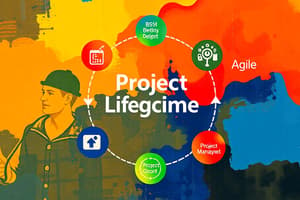Podcast
Questions and Answers
In project management, what is the primary difference between 'projects' and 'operations'?
In project management, what is the primary difference between 'projects' and 'operations'?
- Projects are managed with hard skills, while operations are managed with soft skills.
- Projects are temporary and unique, while operations are ongoing and repetitive. (correct)
- Projects are ongoing and repetitive, while operations are temporary and unique.
- Projects focus on creating tangible goods, while operations focus on providing services.
Which of the following is the MOST accurate description of the purpose of a project charter?
Which of the following is the MOST accurate description of the purpose of a project charter?
- To serve as a marketing document to attract potential investors and secure funding for the project.
- To formally authorize the project manager and ensure a common understanding among stakeholders. (correct)
- To outline the project's scope, deliverables, and acceptance criteria in great detail.
- To provide a detailed budget for the project, including all anticipated expenses.
What is the key focus of 'Plan Scope Management' in the context of project management?
What is the key focus of 'Plan Scope Management' in the context of project management?
- Identifying potential risks and developing mitigation strategies.
- Negotiating and securing the project budget with stakeholders.
- Assigning roles and responsibilities to the project team members.
- Defining and documenting how the project scope will be managed throughout the project lifecycle. (correct)
In project management, what is the MAIN purpose of a Work Breakdown Structure (WBS)?
In project management, what is the MAIN purpose of a Work Breakdown Structure (WBS)?
Why is it important to 'Establish Change Control' in project management?
Why is it important to 'Establish Change Control' in project management?
In project scheduling, what does the 'Critical Path' refer to?
In project scheduling, what does the 'Critical Path' refer to?
Which of the following BEST describes the 'PMI Talent Triangle'?
Which of the following BEST describes the 'PMI Talent Triangle'?
Which of the following is an example of 'compressing schedules'?
Which of the following is an example of 'compressing schedules'?
What is the PRIMARY significance of 'resource availability and constraints' in project resource management?
What is the PRIMARY significance of 'resource availability and constraints' in project resource management?
In the context of Agile project management, what does 'rolling wave planning' primarily involve?
In the context of Agile project management, what does 'rolling wave planning' primarily involve?
Flashcards
What is a Project?
What is a Project?
A unique, time-bound effort with a clear start and end, creating a product or service that adds business value.
Project Management
Project Management
The application of knowledge, skills, tools, and techniques to meet project requirements.
Projects vs. Operations
Projects vs. Operations
Projects are temporary endeavors, while operations are ongoing and repetitive activities.
Hard Skills vs. Soft Skills
Hard Skills vs. Soft Skills
Signup and view all the flashcards
Project Life Cycle
Project Life Cycle
Signup and view all the flashcards
Agile Approach
Agile Approach
Signup and view all the flashcards
Project Charter
Project Charter
Signup and view all the flashcards
Purpose of Project Charter
Purpose of Project Charter
Signup and view all the flashcards
Plan Scope Management
Plan Scope Management
Signup and view all the flashcards
Work Breakdown Structure (WBS)
Work Breakdown Structure (WBS)
Signup and view all the flashcards
Study Notes
Chapter 1: Introduction to Project Management
What Is a Project?
- Projects are unique and time-bound with a defined start and end.
- Projects deliver a unique product or service that adds business value.
- Stakeholders can influence or be influenced by the project.
- Project management involves using knowledge, skills, tools, and techniques to achieve project goals.
History of Project Management
- Project management has existed since the beginning of history.
- Formal project management began in the 1950s with a focus on scheduling and control.
- In the 1990s and 2000s, the IT and telecom industries accelerated the growth of project management.
- More recent trends include a focus on communication, leadership, teamwork, and Agile methodologies.
How Can Project Work Be Described?
- Projects are temporary, whereas operations are ongoing.
- Project skills can be divided into hard (technical) and soft (leadership, communication) skills.
- The project life cycle includes initiating, planning, executing, and closing.
- The Agile approach is iterative, adaptive, and flexible.
Understanding Projects
- PMI is the Project Management Institute.
- PMBOK® is the Project Management Body of Knowledge.
- The PMI Talent Triangle includes technical, leadership, and strategic skills.
- Project selection involves goals, constraints, and success criteria.
- Project types are based on industry, size, and scope.
- The scalability of project tools means tailoring tools to project complexity.
Project Roles
- Traditional project roles include executive, managerial, and associate roles.
- Traditional executive roles are Sponsor, Customer, Steering Team, and PMO.
- Traditional managerial roles are Project Manager, Functional Manager, and Facilitator.
- Traditional associate roles are Core Team Member and SME (Subject Matter Expert).
- Agile project roles include executive, managerial, and associate roles. Agile executive roles are Customer (Product Owner), Sponsor, and Portfolio Team.
- Agile managerial roles are Scrum Master, Functional Manager, and Coach.
- The agile associate role is Team Member.
PMBOK 7e Guide
- The ANSI/PMI 99-001-2021 Standard covers updated principles and guidelines for project management.
Agile
- Agile is iterative, while traditional project management is sequential.
- Agile Manifesto Principles are used.
- Agile terminology is common in project management.
Chapter 3: Project Charter
What is a Project Charter?
- A project charter is an informal contract between the project team and the sponsor.
Why Is a Project Charter Used?
- The project charter authorizes the project manager, ensures common understanding, helps commitment, and screens out weak projects.
When Is a Charter Needed?
- The decision to use a charter depends on the project size and complexity.
Typical Elements in a Project Charter
- Typical elements include:
- Title
- Scope Overview, describing what needs to be delivered
- Business Case, explaining why the project is important
- Background, providing an optional detailed justification
- Milestone Schedule, outlining a high-level timeline and acceptance criteria
- Risks, Assumptions, and Constraints
- Resource Estimates, including budget and staffing needs
- Stakeholder List
- Team Operating Principles, describing how the team will work together
- Lessons Learned from past projects
- Signatures and Commitment, indicating approval and commitment
Constructing a Project Charter
- Charter construction involves collaboration, ideally with the team drafting and the sponsor approving.
- The Scope Overview and Business Case should be concise and clear.
- The Milestone Schedule can be a table with key dates and evaluation criteria.
- Risk Analysis involves identifying and planning for risks.
- Resource Needs should estimate budget and staffing.
- The Stakeholder List should prioritize key stakeholders.
- Team Principles & Lessons contribute learned guidelines for team collaboration.
- Signatures indicate formal approval.
Ratifying the Project Charter
- Ratification involves discussion and approval, reviewing the charter with the sponsor and team before finalizing.
PMBOK Guide 7e
- The PMBOK Guide 7e focuses on Stakeholders, Team, Development, Planning, Measurement, and Uncertainty.
Agile Projects and Charters
- Agile terminology is used in agile project chartering.
Chapter 7: Scope Management & WBS
Plan Scope Management
- Defines how the Project scope is managed.
- Product Scope refers to features and functions.
- Project Scope details what work is required.
Collect Requirements
- Understand Objectives to ensure clarity.
- Gather Stakeholder Needs using various methods.
- Define Needs as Requirements, in which traceability is key.
Define Scope
- Defining scope establishes a foundation for planning and prevents scope creep.
- Steps include: listing deliverables and acceptance criteria, and establishing project boundaries.
Work Breakdown Structure (WBS)
- A Work Breakdown Structure (WBS) is a hierarchical breakdown of project deliverables.
- Using a WBS ensures completeness and aids planning.
- WBS formats include indented outline, org chart, and free form.
- Work Packages are the lowest level and are used for planning.
- The steps to construct a WBS are to identify deliverables, decompose, and review for completeness.
Establish Change Control
- Establishes change control to manage and evaluate changes effectively.
PMBOK Guide 7e Domains
- PMBOK Guide 7e Domains consists of Team, Planning, Delivery, Measurement, and Uncertainty.
Agile Projects
- Agile handles scope flexibly through prioritized backlogs.
Using MS Project for WBS
- It's possible to set up a WBS using software tools like MS Project.
Chapter 8: Project Scheduling
Plan Schedule Management
- PMI’s 7 time management processes include defining, sequencing, and controlling activities.
Purposes of a Project Schedule
- Determines the project completion date and tracks progress.
Historical Development
- PERT and CPM were developed in the 1950s, leading to modern software tools.
How Schedules Are Created
- Creating schedules considers logical order, duration, resources, and constraints.
Define Activities
- Activities are derived from WBS work packages.
Sequence Activities
- Sequencing activities involves leads & lags, and dependency types (FF, SS, SF).
Estimate Activity Duration
- Estimation considers uncertainty, learning curves, and scheduling risks.
Develop Project Schedules
- Developing project schedules Identifies the Critical Path using forward/backward pass and Gantt Charts for visual representation.
Uncertainty in Schedules
- PERT & Monte Carlo Simulations help with uncertain estimates.
Agile Scheduling
- Agile scheduling uses rolling wave planning and backlog prioritization.
Chapter 9: Resourcing and Scheduling Adjustments
Resourcing Skills
- Resourcing involves both technical & behavioral skills.
- Effective resource management balances science and art.
Estimating Resource Needs
- Estimating resource needs consists of identifying resource availability and constraints.
Plan Resource Management
- Planning resource management utilizes the Resource Breakdown Structure (RBS).
Team Composition Issues
- Teams can be cross-functional, co-located, virtual, or outsourced.
Assigning Resources
- Resource assignment uses the RACI Chart and Gantt Chart.
Resolving Resource Overloads
- Resolution methods include reassigning work, delaying non-critical activities, or adding resources.
Compressing Schedules
- Compressing schedules by Crashing means trading cost for time and Fast-Tracking involves trading risk for time.
Alternative Scheduling Methods
- Alternative scheduling methods are Critical Chain Project Management (CCPM), Reverse Phase Scheduling, and Rolling Wave Planning.
Studying That Suits You
Use AI to generate personalized quizzes and flashcards to suit your learning preferences.




